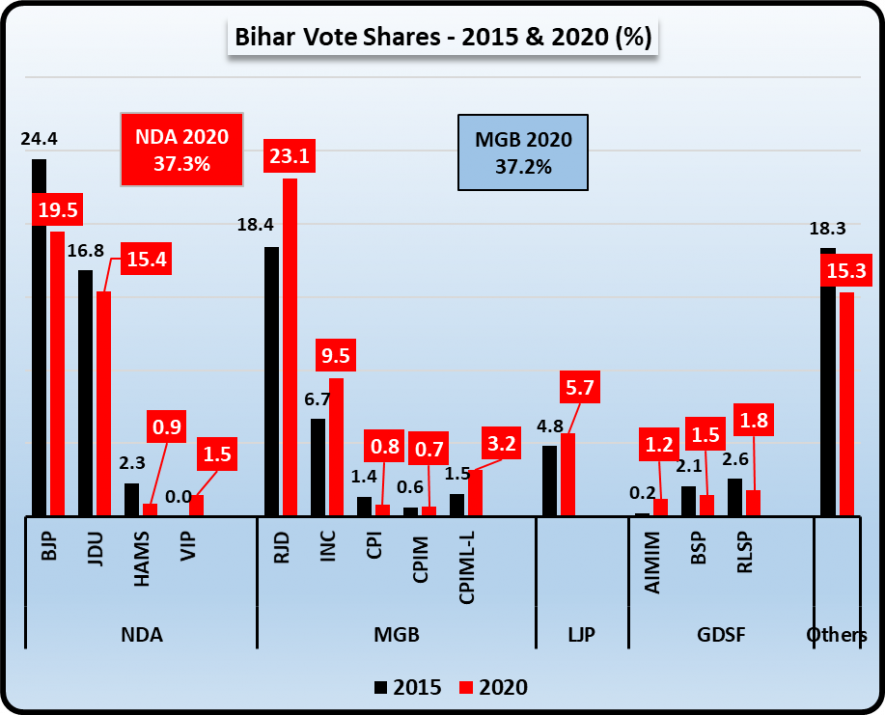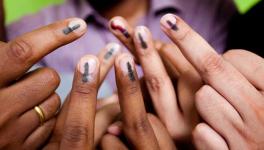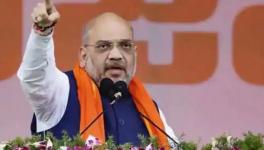Bitter-Sweet Lessons from Bihar: Some Myths, Some Truths
Representational use only. Image Source: BT
Late on Tuesday night (November 10), as the counting was being finalised in some 20 neck-to-neck seats in Bihar, the Rashtriya Janata Dal (RJD) and the Communist Party of India (Marxist Leninist) Liberation protested against the pressure exercised by the Nitish Kumar government on various Returning Officers to declare results. They alleged that seats which were being won by the Mahagathbandhan (MGB) of opposition parties were declared for the incumbent parties.
What happens to these seats will become clear in a few days, but as of now, the Nitish Kumar led ruling alliance is the winner, albeit with just three seats more than the half-way mark of 122 in the 243-member Bihar Assembly. The MGB tally is 110 while another front of small parties has managed six seats.
Fractured Mandate – Just 13,000 votes separate two alliances
What is remarkable is that the two main fronts – the BJP-led National Democratic Alliance (NDA) and the MGB – have ended up at nearly the same vote shares of 37.3% and 37.2% respectively, which works out to a difference of just about 13,000 votes only. [See chart below, showing alliances as they were in 2020; in 2015 JDU contested with the then MGB but switched over to an alliance with BJP in 2017].
The Lok Janshakti Party (LJP) led by the late Ramvilas Paswan’s son, Chirag Paswan, has garnered 5.7% votes while the ‘Grand Secular Democratic Front’ of small parties has got about 4.5% votes. The people of Bihar have delivered a fractured mandate, although in the first-past-the-post system it means that the incumbent NDA will return to power. Clearly, the verdict is not an approval of the Nitish Kumar rule of 15 years of which 13 years were in alliance with the BJP. But neither have the people been confident enough to approve of the MGB, assuming that the results have not been manipulated.

As always happens in Indian elections, several myths created and fostered during the campaign have been shattered while some hard truths, too, have emerged.
Caste-based Voting Broken …. Somewhat
MGB’s appeal to Bihar voters for supporting their economic programme of more jobs, industrialisation, food security, better prices to farmers, etc., cut across caste barriers that are usually thought to determine voting behaviour and largely become the sole tools for understanding elections. Unemployment rates in Bihar have been in double digits for two years and the state’s people have still not recovered from the 46% unemployment seen during the April-May months of lockdown. The MGB promise to provide 10 lakh government jobs if elected electrified the people and contributed significantly to drawing people, especially youth, from all castes. The Left too, with its cross-caste base helped in this process.
Also read: Bihar Elections: Why Jobs Have Become the Key Issue
However, the appeal of MGB could not completely break down the caste-based political mobilisation that had been institutionalised in the BJP-led alliance, which had parties representing the Mallah or Nishad (boatmen) caste, or the most oppressed dalit Musahars. The lure of power and patronage continues to draw leaders of these castes to political alliances, though history tells us that the common people from that caste rarely benefit in material terms. This election in Bihar saw a partial dissolution of caste based voting, but not sufficient to defeat the NDA.
Rise of Left
Bihar has a history of radical and Left movements going back decades. But ideological differences and the emergence of Mandal politics had pushed the Left to the margins. In the past several years, Left movements for land, for trade union rights and among students, as also defence of oppressed sections like the religious minorities and dalits and adivasis had led to an invisible consolidation taking place.
This emerging support has come into its own in this election, although being part of the grand alliance has undoubtedly helped in terms of votes. The three main left parties – Communist Party of India, CPI (Marxist) and CPI (ML)-Liberation – were recognised as an asset and included in the MGB. They contested 29 seats and won 18 of them. They have got 4.5% of the votes polled, up from 3.5% last time. Some of their candidates lost very marginally. In the razor-edge election, these 18 seats form a formidable bulwark against the BJP and its allies. The Left’s contribution was also significant in other seats where its highly motivated cadres worked for the allies’ candidates, and successfully mobilised sections of society that may otherwise not have supported MGB.
In the coming months, the presence of a solid Left bloc in the Assembly will be very helpful in giving a secular and people-oriented thrust to the Opposition as it confronts the ruling BJP-JDU alliance.
LJP – A BJP Pawn
A rather bizarre and intriguing game was played out in these elections which revealed the devious ambition of BJP. Its ally at the Centre, LJP declared it would not support candidates of Nitish Kumar’s JD(U) and devoted the whole campaign to attacking him. In all likelihood, this gambit was covertly inspired and supported by the BJP itself which was nursing ambitions of becoming the bigger party vis a vis JDU, although in later stages, all the BJP bigwigs denied that LJP was their pawn. This happened because they realised that LJP was causing damage to the NDA’s total numbers in what was clearly a tight race.
As the results show, LJP appears to have caused the defeat of at least 33 JD(U) candidates since the votes LJP candidates got in these seats are more than the margin with which JD(U) candidates lost. This of course assumes that if LJP was supporting JD(U) then the same number of votes would have been transferred to JD(U). This is not necessary, but still, it gives a sense of the damage to JD(U) caused by its own ally, the BJP. It is also a warning to various parties that ally with the BJP in elections – they will be gobbled up some time or other.
Congress Drags MGB Down
The Congress could manage to win only 19 seats out of the 70 it contested as part of the MGB, one of the poorest rates of wins. Although on paper it has improved its vote share from 6.7% in 2015 to 9.5% this time, this is largely the effect of the energised MGB. The Congress remains a moribund organisation with little base or structure to mobilise votes, being largely absent on the ground at all times except during elections. It still has some goodwill among some sections, and may become a choice of last resort, but as a viable alternative it is fast sinking. As leaders of the Left have said later, instead of giving it 70 seats if the Left had been given more seats, the results would have been different.
In sum, the Bihar elections offer several bitter-sweet lessons: a people-oriented front with alternative policies is needed, but not just for elections, it needs to work and fight for the people throughout. In campaigning, you can make only so much headway, as did the MGB. Had this alliance been on the forefront for the past five years – as its Left component was – the results would have been decisively favourable.
Also read: Lesson from Bihar: Suffering Does Not Make People Shift Party Loyalties
Get the latest reports & analysis with people's perspective on Protests, movements & deep analytical videos, discussions of the current affairs in your Telegram app. Subscribe to NewsClick's Telegram channel & get Real-Time updates on stories, as they get published on our website.
























